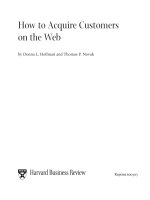Tài liệu Opportunities to Reduce Greenhouse Gas Emissions through Materials and Land Management Practices docx
Bạn đang xem bản rút gọn của tài liệu. Xem và tải ngay bản đầy đủ của tài liệu tại đây (1.57 MB, 98 trang )
OpportunitiestoReduceGreenhouseGasEmissionsthroughMaterialsand
LandManagementPractices
U.S.EnvironmentalProtectionAgency
OfficeofSolidWasteandEmergencyResponse
September2009
LegalNote
Thisdocumentcontainsinformationdesignedtobeusefulandhelpfultogovernments,thepublic,andtheregulated
community.Thisdocumentdoesnotimposelegallybindingrequirements,nordoesitconferlegalrights,imposelegal
obligations,orimplementanystatutoryorregulatoryprovisions.Thisdocumentdoesnotrestrict,expandorotherwise
changeEPA'sauthoritytoaddressgreenhousegasemissionsunderexistingstatutes.Thisdocumentdoesnotchangeor
substituteforanystatutoryorregulatoryprovisions.ThisdocumentpresentstechnicalinformationbasedonEPA’scurrent
understandingofthelinkbetweenglobalclimatechangeandmaterialsandlandusemanagementprograms.Finally,thisis
alivingdocumentandmayberevisedperiodicallywithoutpublicnotice.
TheEPAwelcomespubliccommentsonthisdocumentatanytimeandwillconsiderthosecomments
inanyfuturerevisionsofthisdocument.
TableofContents
ExecutiveSummary 1
Introduction 1
UnderstandingU.S.GHGEmissions 2
LookingForward 5
Section1Introduction 6
Section2 UnderstandingU.S.GHGEmissions 10
Sector‐BasedViewofU.S.GHGEmissions 10
Systems‐BasedViewofU.S.GHGEmissions 11
MaterialsManagement 12
LandManagement 13
Other 16
Summary 18
Section3 PotentialGHGReductionsThroughMaterialsandLandManagement 19
ReducingGHGEmissionsthroughMaterialsManagementPractices 19
PotentialGHGEmissionsReductionsfromMaterialsManagement 22
ReducingorAvoidingGHGEmissionsthroughLandManagementPractices 23
PotentialGHGEmissionsReducedorAvoidedfromLandManagement 26
Section4LookingForward 28
AppendixA
TechnicalSupportforOpportunitiestoReduceGreenhouseGasEmissionsthroughMaterials
andLandManagementPractices A‐1
OpportunitiestoReduceGreenhouseGasEmissionsthroughMaterialsandLandManagementPractices September2009
ExecutiveSummary
TheIntergovernmentalPanelonClimateChangehasdeterminedthat“warmingoftheclimatesystem
isunequivocal,asisnowevidentfromobservationsofincreasesinglobalaverageairandocean
temperatures,widespreadmeltingofsnowandiceandrisingglobalaveragesealevel.”
1
TheU.S.
EnvironmentalProtectionAgency(EPA)hasproposedthatclimatechangeisprimarilytheresultof
greenhousegas(GHG)emissions,itseffectswillworsenovertimeintheabsenceofregulatoryaction,
andtheoverallrateandmagnitudeofhuman‐inducedclimatechangewilllikelyincrease,suchthat
riskstopublichealthandwelfarewilllikewisegrowovertimesothatfuturegenerationswillbe
especiallyvulnerable;theirvulnerabilitywillincludepotentiallycatastrophicharms.
2
Torespondtotheriskassociatedwithclimatechange,thisdocumentdescribesthelinkbetween
climatechangeandthematerialsandlandmanagementprogramscarriedoutbyEPA’sOfficeofSolid
WasteandEmergencyResponse(OSWER),anditsfederal,regional,state,tribal,community,andother
publicandprivatepartners.Thepurposeofthisdocumentistwo‐fold.First,inordertoincrease
understandingofthelinkbetweenmaterialsandlandmanagementandGHGemissions,thisdocument
presentsanestimateoftheportionofU.S.GHGemissionsassociatedwithmaterialsandland
managementpractices.Second,itpresentsasetofmaterialsandlandmanagementscenarios—
referredtoastotaltechnicalpotentialscenarios—asafirststeptoidentifyingareasofopportunityfor
EPAanditspartnerstoreduceGHGemissionsthroughmaterialsandlandmanagement.
Introduction
OSWERanditspartnersimplementenvironmentalprogramsthatarebroadlycategorizedintothree
areas:materialsmanagementthroughresourceconservationandrecovery;landmanagementthrough
preventionofcontaminantreleasesandcleanupandreuseofcontaminatedsites;andemergency
responseandpreparedness.Thesethreeprogramareasallhavedirectimpactsoncommunitiesacross
theUnitedStates.Materialsmanagementreferstohowwemanagematerialresourcesastheyflow
throughtheeconomy,fromextractionorharvestofmaterialsandfood(e.g.,mining,forestry,and
agriculture),productionandtransportofgoods,provisionofservices,reuseofmaterials,and,if
necessary,disposal.EPApromotesmaterialsmanagementapproachesthatservehumanneedsby
usingandreusingresourcesproductivelyandsustainablythroughouttheirlifecycles,minimizingboth
theamountofmaterialsinvolvedandtheassociatedenvironmentalimpacts.Landmanagementrefers
tohowwemanageanduselandtoprovideopenspaceandhabitat,food,naturalresources,and
placesforpeopletolive,work,andrecreate.EPApromotesintegratedlandmanagementstrategies
thatuselandasproductivelyandsustainablyaspossiblebypreventingandminimizingtheoccurrence
ofcontaminationandcleaningup,reusing,andrestoringcontaminatedlandforbeneficialreuse.EPA’s
emergencyresponseandpreparednessprogramswillhaveakeyroleinadaptingtotheenvironmental
changesspurredbyclimatechange.
Howwemanageourmaterialsandland—twoofOSWER’sthreecoreprogramareas—hasasignificant
impactonU.S.GHGemissionsandsinks.Strategiesforreducingemissionsthroughmaterialsandland
managementalsohavesubstantialenvironmentalandeconomicco‐benefitsforcommunities.
1
IntergovernmentalPanelonClimateChange.FourthAssessmentReport(AR4).p.30.Availableat: />report/ar4/syr/ar4_syr.pdf
2
ProposedEndangermentandCauseorContributeFindingsforGreenhouseGasesUnderSection202(a)oftheCleanAirAct.ProposedRule.74Fed.
Reg.18886‐18910.April24,2009.
1
OpportunitiestoReduceGreenhouseGasEmissionsthroughMaterialsandLandManagementPractices September2009
Additionally,unlikemanyGHGmitigationoptions,materialsandlandmanagementareheavily
influencedbystatesandcommunities.Workingwithitspartners,EPAcanleverageitsmaterialsand
landmanagementprogramstoachievemeasurableGHGreductionswhileyieldingmultiple
environmental,humanhealth,andeconomicbenefitsforcommunitiesandthenation.Thisdocument
promotestherecognitionthatmaterialsandlandmanagementprograms,whilecomplementingother
EPAprogramgoals,canalsoproducesignificantclimatechangemitigationbenefits.
UnderstandingU.S.GHGEmissions
TheUnitedStatesannuallyreportsitsGHGemissionsintheInventoryofU.S.GreenhouseGas
EmissionsandSinks(“theInventory”).
3
Thisreportquantifiesthecountry’sprimaryanthropogenic
sourcesandsinksofGHGemissionsbasedoncomprehensiveanddetailedmethodologiesconsistent
withinternationalguidancethatenablespartiestotheUnitedNationsFrameworkConventionon
ClimateChange(UNFCCC)tocomparetherelativecontributionofdifferentemissionsourcesandGHGs
toclimatechange.TheinformationintheInventoryisoftensummarizedbyapportioningemissionsto
economicsectors.Thissector‐basedviewofdataintheInventoryisimportantforframingarangeof
GHGemissionsmitigationstrategies,includingend‐of‐pipestrategiesforreducingemissionsand
technologysubstitutionswithinasector.
Tobetterunderstandanddescribetheconnectionsbetweenmaterialsandlandmanagementand
climatechange,thisreportpresentsasystems‐basedviewofU.S.GHGemissions,whereeachsystem
representsandcomprisesallthepartsoftheeconomyworkingtofulfillaparticularneed.Forexample,
theprovisionoffoodsystemincludesallemissionsfromtheelectricpower,transportation,industrial,
andagriculturalsectorsassociatedwithgrowing,processing,transporting,anddisposingoffood.The
systemsviewishelpfulforframingopportunitiestoreduceGHGemissionsthroughprevention‐
orientedmitigationstrategiesthatactacrossanentiresystem.Thesystemsareselectedtoillustrate
theGHGemissionsassociatedwithmaterialsandlandmanagement,asshowninFigureES‐1.Appendix
Aprovidesthemethodologyusedforthisanalysis,includingkeyassumptionsandreferencesfor
sourcedata.
Combined,materialsmanagementisassociatedwithanestimated42%oftotalU.S.GHGemissions
andlandmanagementisassociatedwithanestimated16%oftotalU.S.GHGemissions.Basedona
preliminaryestimateprovidedinthisreport,GHGemissionsfromgreenfielddevelopmentare
equivalenttoapproximatelyanadditional4%oftotalU.S.emissions.
4
Theland‐basedcarbonsink
reportedintheInventoryofU.S.GreenhouseGasEmissionsandSinkshasbeenincludedinthisfigure
tohelpconveytheeffectlandmanagementhasonU.S.emissionsandsinks.Theland‐basedcarbon
sinkisequivalentto13%of2006U.S.GHGemissions.
5
FigureES‐1showstherelativemagnitudeoftheemissionsassociatedwithmaterialsandland
management.ByallocatingtheemissionsreportedintheInventoryofU.S.GreenhouseGasEmissions
3
U.S.EPA.2008.InventoryofU.S.GreenhouseGasEmissionsandSinks:1990‐2006.Availableat:
/>version,InventoryofU.S.GreenhouseGasEmissionsandSinks:1990‐2007,waspublishedin2009andcanbefoundat
eport.html.
4
EmissionsfromgreenfielddevelopmentarenotcalculatedintheU.S.Inventory,butthisestimatemayoverlapwithexistinglandsinkvalue.
5
U.S.EPA.2008.InventoryofU.S.GreenhouseGasEmissionsandSinks:1990‐2006.p.ES‐14.Availableat:
/>
2
OpportunitiestoReduceGreenhouseGasEmissionsthroughMaterialsandLandManagementPractices September2009
andSinksbysystem,theimpactofdecisionsrelatedtomaterialsandlandmanagementonthe
country’stotalGHGemissionsandsinksisevident.
Figure ES-1
Systems-Based View of U.S. GHG Emissions (2006)
This figure presents the U.S. GHG emissions data reported in the Inventory of U.S. Greenhouse Gas Emissions and Sinks, allocated to
systems, and by materials and land management, as described in Appendix A. Emissions from U.S. territories are not included in this figure.
Entire circle: Gross U.S. Emissions
Inner portion of circle: Net U.S. Emissions
* The Land Sink, represented by the outer ring, offset the equivalent of 13% of total U.S. anthropogenic emissions in 2006. It is graphically represented here
as a semi-transparent ring that erases a portion of emissions from all other slices shown in the pie chart. The entire pie chart represents total U.S.
emissions in 2006; once the offset provided by the Land Sink is applied, the inner portion of the pie chart represents net U.S. emissions.
** Greenfield development represents emissions from land clearing (equivalent to roughly 4% of U.S. emissions in 2006); this calculation is not included in
the Inventory of U.S. Greenhouse Gas Emissions and Sinks, and is therefore depicted outside of the pie chart. It may include some overlap with the
existing land sink value.
PotentialGHGReductionsthroughMaterialsandLandManagement
SignificantGHGemissionreductionshavebeenachievedtodateintheUnitedStatesbyEPA,states,
localgovernments,andstakeholdersthroughnumerousmaterialsandlandmanagement‐related
activities.
6
Selectedexamplesinclude:
• In2006,U.S.municipalsolidwaste(MSW)recyclingresultedintheavoidanceofnearly183
millionmetrictonsofcarbondioxideequivalent(MMTCO
2
E)inGHGemissions.
7
• In2006,waste‐to‐energyrecoverysystemscombustedMSWandresultedintheavoidanceof17
MMTCO
2
EinGHGemissions.
8
• In2005,EPA’sWasteWisepartnersreportedsourcereductionandrecyclingactivitiesthat
resultedintheavoidanceof27MMTCO
2
EinGHGemissions.
9
6
ThefollowingtoolswereusedtocalculatetheselectedexamplesofGHGemissionsreductions,inadditiontothedatasourcesreferencedforeach
examplebelow:U.S.EPA.March2009.GreenhouseGasEquivalenciesCalculator;U.S.EPA.September2008.WAsteReductionModel(WARM);and
Fogt,Robert.2008.OnlineConversionToolforEnergy.
7
U.S.EPA,OfficeofSolidWasteandEmergencyResponse.November2007.MunicipalSolidWasteGeneration, Recycling,andDisposalintheUnited
States:FactsandFiguresfor 2006,p.1‐8.
8
Ibid.
9
U.S.EPA.October2006.WasteWise2006AnnualReport .p.1.Availableat: />
3
OpportunitiestoReduceGreenhouseGasEmissionsthroughMaterialsandLandManagementPractices September2009
TohelpillustratethepotentialforGHGreductionandavoidanceopportunitiesfrommaterialsandland
managementpractices,thisanalysisincludesseveral“totaltechnicalpotential”scenarios.BoxES‐1
summarizesthesescenariosandAppendixAdescribestheanalyticalmethodology,assumptions,and
datasourcesusedtocalculatethepotentialimpactsforthesehypotheticalchangesinmaterialsand
landmanagementpractices.
ThetermtotaltechnicalpotentialreferstotheestimatedGHGemissionreductionthatcouldoccurif
thescenariospresentedareachieved,settingasideeconomic,institutional,ortechnological
limitations.Suchscenarios,whichareacommonfirststepinclimatepolicyanalysis,allowforthe
examinationoftheGHGreductionpotentialofvariousmitigationstrategiescontainedinthose
scenarios.Thesetotaltechnicalpotentialscenariosareusefulforscopingtheorder‐of‐magnitude
impactofanactivityandidentifyingareasofpromiseformoredetailedanalysisandpotentialactivity.
TheyalsoillustratehowchangesinbehaviorcanleaddirectlytosignificantreductionsofGHG
emissionsonanationalscale.
Thetotaltechnicalpotentialscenariospresentedhererepresentearlyanalysisbasedonexistingand
availabledata.Asmoreanalysisiscompleted,totaltechnicalpotentialscenarioscanbegeneratedfora
greaternumberofmaterialsandlandmanagementapproaches.
Box ES-1: Summary of Total Technical Potential Scenarios
Source Reduction
Estimated GHG
Emission Benefit*
Reduce packaging use by:
50% 40—105
MMTCO
2
E/yr
25% 20—50
MMTCO
2
E/yr
Reduce use of non-packaging paper products by:
10
50% 20—70
MMTCO
2
E/yr
25% 10—35
MMTCO
2
E/yr
Extend the life of personal computers by:
50% 25
MMTCO
2
E/yr
25% 15
MMTCO
2
E/yr
Reuse/Recycling
Increase recycling of construction and demolition debris to:
100% 150
MMTCO
2
E/yr
50% 75
MMTCO
2
E/yr
25% 40
MMTCO
2
E/yr
Increase national municipal solid waste (MSW) recycling and composting rate from 2006 rate (32.5%) to:
100% 300
MMTCO
2
E/yr
50% 70—80
MMTCO
2
E/yr
Increase composting of food scraps from 2006 rate (2%) to:
100% 20
MMTCO
2
E/yr
50% 10
MMTCO
2
E/yr
25% 5
MMTCO
2
E/yr
Energy Recovery / Disposal
Combust percentage of currently landfilled MSW:
100% 70—120
MMTCO
2
E/yr
50% 35—60
MMTCO
2
E/yr
25% 20—30
MMTCO
2
E/yr
Combust MSW remaining if national recycling rate is increased to 50%:
65—110
MMTCO
2
E/yr
Capture percentage of currently emitted methane at U.S. landfills for electricity generation:
100% 150
MMTCO
2
E/yr
50% 70
MMTCO
2
E/yr
25% 35
MMTCO
2
E/yr
10
Non‐packagingpaperproductsincludemagazinesandthirdclassmail,newspaper,officepaper,phonebooks,andtextbooks.
4
OpportunitiestoReduceGreenhouseGasEmissionsthroughMaterialsandLandManagementPractices September2009
5
Box ES-1: Summary of Total Technical Potential Scenarios
Land Revitalization
Estimated GHG
Emission Benefit*
Shift 60% of expected new development to compact development patterns:
11
79
MMTCO
2
E/yr
Reuse percentage of qualifying EPA-tracked contaminated land for utility-scale solar:
12
100% 2,200
MMTCO
2
E/yr
50% 1,100
MMTCO
2
E/yr
25% 540
MMTCO
2
E/yr
100% 40
MMTCO
2
E/yr Reuse percentage of qualifying EPA-tracked contaminated land for community and utility-scale
wind:
13
50% 20
MMTCO
2
E/yr
25% 10
MMTCO
2
E/yr
100% 0.4
MMTCO
2
E/yr
50% 0.2
MMTCO
2
E/yr
Reduce electricity use for the most energy-intensive treatment technolo
g
ies at National Priorities List
sites by:
25% 0.1
MMTCO
2
E/yr
Reforest percentage of qualifying former mine lands for carbon sequestration:
100% 4
MMTCO
2
E/yr
50% 2
MMTCO
2
E/yr
25% 1
MMTCO
2
E/yr
* Most of the total technical potential scenarios presented in this table have been rounded to one significant figure. See following Appendix A for more
detail on these estimates.
LookingForward
ThereisastronglinkbetweenU.S.GHGemissionsandthemanagementofmaterialsandland.EPA,
alongwithitspartners,canhelpaddressthechallengesofglobalclimatechangethroughmaterialsand
landmanagementprograms.Aswedevelopprogramsandpolicieswithourpartners,moredetailed
studiesthataccountforboththelimitationsandopportunitiesofeconomic,technical,andpolicy
aspectsofthescenariosintroducedinthispaperwillbeneeded.
11
Expectedannualbenefitthrough2030.
12
The100%scenariorepresents141timestheprojectedincreaseinsolarpowerbetween2008and2030.SeeAppendixformoredetail.
13
The100%scenariorepresents75%ofprojectedincreaseinwindpowerbetween2008and2030.SeeAppendixformoredetail.
OpportunitiestoReduceGreenhouseGasEmissionsthroughMaterialsandLandManagementPractices September2009
SECTION1
INTRODUCTION
Climatechangeisaseriousglobalchallenge.Atmosphericgreenhousegas(GHG)concentrationshave
increasedsignificantlyfrompre‐industriallevelsasaresultofhumanactivities.Warmingoftheclimate
systemisunequivocal,asisnowevidentfromobservationsofincreasesinglobalaverageairandocean
temperatures,widespreadmeltingofsnowandice,andrisingglobalaveragesealevel.
14
Furthermore,
theU.S.EnvironmentalProtectionAgency(EPA)hasproposedthatclimatechangeisprimarilythe
resultofGHGemissions,itseffectswillworsenovertimeintheabsenceofregulatoryactionandthe
overallrateandmagnitudeofhuman‐inducedclimatechangewilllikelyincrease,suchthatrisksto
publichealthandwelfarewilllikewisegrowovertimesothatfuturegenerationswillbeespecially
vulnerable;theirvulnerabilitywillincludepotentiallycatastrophicharms.
15
Agrowingbodyofliteraturediscussespotentialimpactsofclimatechangeandthemeanstoadaptto
thesechanges.Itispredictedthat“evenwhereregionsonthewholemaybeabletosuccessfullyadapt
toalimitedclimatechange,specificindividualsandcommunitiescouldstillbedisplacedandharmed
byclimatechange.”
16
Ofparticularconcernarethosecommunitiesthathavestrongtiesand
associationswithspecificareasandresourcesthatareexposedandsensitivetoclimatechange(e.g.,
throughsea‐levelrise,increaseddrought,extremeheat),deriveashareoftheirincomefromclimate
sensitiveactivitiessuchasagricultureorfishing,andlackfinancialandothermeanstoadapt.
17
Arctic
communities,forexample,arealreadyadaptingtoclimatechange,butbothinternalandexternal
stressorschallengetheiradaptivecapacity.
18
TheU.S.federalgovernmenthasimplementedprogramstoslowthegrowthofGHGemissions,
strengthenscience,technologyandinstitutions,andenhanceinternationalcooperation.Sincethe
early1990s,thefederalgovernmenthaspromotedvoluntaryandincentive‐basedprogramstoreduce
emissionsandestablishedprogramstoadvanceclimatetechnologyandscience.Theseprogramsfocus
onenergyefficiency,renewableenergy,methaneandothernon‐carbondioxidegases,agricultural
practices,andimplementationoftechnologiestoachieveGHGreductions.InApril2009theEPA
Administratorproposedtofindthatgreenhousegasesintheatmospheremayreasonablybe
anticipatedtoendangerpublichealthandwelfarewithinthemeaningofSection202(a)oftheClean
AirAct.TheAdministratorfurtherproposedtofindthatthecombinedemissionsofCO
2
,CH
4
,N
2
O,and
HFCsfromnewmotorvehiclesandnewmotorvehicleenginescontributetotheatmospheric
concentrationsofthesekeygreenhousegasesandhencetothethreatofclimatechange.
19
EPAhas
alsoproposedtorequireGHGemissionsreportingbylargeemittersandannouncedplanstopropose
14
IntergovernmentalPanelonClimateChange.FourthAssessmentReport(AR4).pp.30,74,189.Availableat: />report/ar4/syr/ar4_syr.pdf
15
ProposedEndangermentandCauseorContributeFindingsforGreenhouseGasesUnderSection202(a)oftheCleanAirAct.ProposedRule.74Fed.
Reg.18886‐18910.April24,2009.
16
Easterling,William,Hurd,Brian,andSmith,Joel.2004.CopingwithGlobalClimateChange:TheRoleofAdaptationintheUnitedStates.PewCenter
onGlobalClimateChange.
17
Ibid.
18
IntergovernmentalPanelonClimateChange.2007.SummaryforPolicymakersinClimateChange2007:Impacts,AdaptationandVulnerability.p.15.
CambridgeUniversityPress,Cambridge,UnitedKingdomandNewYork,NY,USA.
19
ProposedEndangermentandCauseorContributeFindingsforGreenhouseGasesUnderSection202(a)oftheCleanAirAct.ProposedRule.74Fed.
Reg.18886‐18910.April24,2009.
6
OpportunitiestoReduceGreenhouseGasEmissionsthroughMaterialsandLandManagementPractices September2009
GHGemissionsstandardsforallnewcarsandlight‐dutytrucks(modelyears2012‐2016)soldinthe
UnitedStates.
20
Throughitsmaterialsmanagementandlandcleanupprograms,EPA’sOfficeofSolidWasteand
EmergencyResponse(OSWER)isanimportantpartnerinaddressingclimatechangeandreducingU.S.
GHGemissionsandhasacommunity‐levelperspectiveontheresponsetoclimatechange.
OSWERanditsregional,state,tribal,community,andotherpublicandprivatepartnersimplement
environmentalprogramsthatareauthorizedbyanumberoffederalstatuteswitharangeofobjectives
tosupportcommunitiesandprotecthumanhealthandtheenvironment.Theseprogramscanbe
broadlycategorizedintothreeareas:
• Materialsmanagement,throughresourceconservationandrecovery,wasteprevention,and
safewastedisposal;
• Landmanagementthroughactivitiesthatpreventpollutantreleases,andencouragecleanup
andreuseofcontaminatedandpotentiallycontaminatedsites;and
• Emergencyresponseto,andpreparednessfor,contaminantreleasesandotherthreatsto
publichealth.
Howwemanageourmaterialsandland—twoofOSWER’sthreecoreareas—hasasignificantimpact
onU.S.GHGemissionsandsinks.
21
PeopleproduceGHGemissionsthroughawidearrayofactivities
andacrossmultiplelocations,includingthegoodsandservicesweconsume,thehomesinwhichwe
live,thebuildingswherewework,thetransportationofourselvesandourgoodsfromplacetoplace,
andthematerialswediscard.Meanwhile,energyconsumption,materialsuse,municipalwaste
generation,andlanddevelopmentrateshavealloutpacedpopulationgrowthoverthelastseveral
decadesintheUnitedStates,contributingtotheimpactoftheseactivities.
22, , ,23 24 25
Thereare
significantopportunitiestoreduceoravoidGHGemissionsbyimprovingournation’smaterialsand
landmanagementpractices;theseapproachescomplementandsupportend‐of‐pipecontrols,sector‐
basedandothermitigationstrategies.
Materialsmanagementreferstohowwemanagematerialresourcesastheyflowthroughthe
economy,fromextractionorharvestofmaterialsandfood(e.g.,mining,forestry,andagriculture),
productionandtransportofgoods,provisionofservices,reuseofmaterials,and,ifnecessary,disposal.
EPApromotesmaterialsmanagementapproachesthatservehumanneedssustainablybyminimizing
theamountofmaterialsinvolvedandtheirassociatedenvironmentalimpacts.
26
20
Seee.g.,ProposedEndangermentandCauseorContributeFindingsforGreenhouseGasesUnderSection202(a)oftheCleanAirAct.ProposedRule.
74Fed.Reg.18886‐18910(April24,2009).NoticeofUpcomingJointRulemakingtoEstablishVehicleGHGEmissionsStandardsandCAFEStandards,
74Fed.Reg.24007(May22,2009).
21
Emergencyresponseandpreparedn esswillbeacentralpartoftheresponsetoclimatechange,butisnotthefocusofthisdocument.
22
U.S.DepartmentofEnergy,EnergyInformationAdministration.EnergyConsumption,Expenditures,andEmissionsIndicators,1949‐2007.
Table1.5Availableat: />23
UniversityofMichigan,CenterforSustainableStudies.2002.U.S.MaterialsUseFactsheet.Availableat: />18.pdf
24
U.S.EPA.2006.SolidWasteManagementandGreenhouseGases:ALifeCycleAssessmentofEmissionsandSinks.p.ES‐1.Availableat:
/>25
KolankiewiczandBeck.2001.WeighingSprawlFactorsinLargeU.S.Cities:AnalysisofU.S.BureauoftheCensus
Dataonthe100LargestUrbanizedAreasoftheUnitedStates.Availableat: />26
U.S.EPA.2003.BeyondRCRA:WasteandMaterialsManagementintheYear2020.Availableat: />“SustainableMaterialsManagement:TheRoadAhead”buildsonthisreportandisscheduledtobepublishedinFall2009
7
OpportunitiestoReduceGreenhouseGasEmissionsthroughMaterialsandLandManagementPractices September2009
UsingmaterialsmanagementapproachestohelpreduceoravoidGHGemissionsisconsistentwith
EPA’svisionandmanyofthestrategiestoincreasetheefficientandsustainableuseofresourcesand
reducewastegenerationaredescribedinBeyondRCRA:WasteandMaterialsManagementintheYear
2020.Someofthestrategiesincludereducingtheamountofmaterialsusedtomakeproductsor
performservicesandinfluencingproductdesign,use,andreusecapabilitiestominimizerawmaterial
inputs,extendproductlifespans,andmaximizetheeaseandfrequencyofsubsequentproduct
disassembly,recycling,and/ortransformationforfurtherproductiveuse.
27
Inadditiontoincreasing
materialefficiencyandreducingwaste,materialsmanagementactivitieshavethepotentialto
significantlyreduceGHGemissions,asdescribedinthefollowingsections.
Landmanagementisatermusedtodescribeseparateorintegratedstrategiesthatinfluencehowwe
manageanduselandtoprovideopenspaceandhabitat,food,naturalresources,andplacesforpeople
tolive,work,andrecreate.Forexample,landmanagementincludesthepracticesofdevelopingland
andmanaginglandforagriculturalandforestrypurposes.Thewaywemanageourlanddirectly
influencesGHGemissionsrelatedtoagriculture,thebuiltenvironment(e.g.,residentialand
commercialemissions),electricityuse,andtransportation.
TheconceptoflandmanagementlinksdirectlytoEPA’svisionofpreventinglandcontamination,in
part,byencouragingsmartgrowth,
28
improvingchemicalandwastemanagementtoprevent
contamination,restoringcontaminatedandpotentiallycontaminatedlandforreusebysociety,and
encouragingthesustainablereuseofproperty.SomelandmanagementapproachescanalsoyieldGHG
emissionreductionsorcanprotectthecarbonsinkprovidedbyU.S.land,whichisfurtherdescribedin
Section2.
Bytakingadvantageofopportunitiespresentedbymaterialsandlandmanagement,EPAandits
partnerscancontributetoareductionoravoidanceofGHGemissionsaswellasimprovementto
publichealthandtheenvironment.
LeveragingOSWERprogramstoachievemeasurableclimatechangebenefitsinnowayreplacesor
supersedesotherOSWERprogramgoals.Rather,thisdocumentpromotestherecognitionthat
materialsandlandmanagementprogramshavesignificantclimatebenefitswhileyieldingpositive
environmental,economic,andsocietalco‐benefitsincommunitiesacrossthecountry.
Inthecaseofmaterialsmanagement,themajorityofGHGreductionbenefitsfromrecyclingorwaste
preventioncomefromtheenergysavingsfromavoidedresourceextractionandmaterials
processing.
29
Thisenergysavingscarriesco‐benefitsofimprovementsinlocalairquality.Similarly,the
conservationofrawmaterialreducesenvironmentaldegradationandwaterpollutionfrommining,
logging,andoilextraction.
Materialsmanagementoptionsoftenalsohaveeconomicbenefitsforcommunities.Forexample,
recyclingatonofmaterialcreatesmanymorejobsthansendingthesamematerialtoalandfill
27
Ibid.
28
Formoreinformationonthedefinitionofsmartgrowth,includingthetenbasicprinciplesofsmartgrowth,andsmartgrowthapproaches,referto:
/>29
U.S.EPA.2006.SolidWasteManagementandGreenhouseGases:ALife‐CycleAssessmentofEmissionsandSinks.Availableat:
/>
8
OpportunitiestoReduceGreenhouseGasEmissionsthroughMaterialsandLandManagementPractices September2009
becauseofthelaborrequiredtocollect,sort,andprocesstherecyclables.
30
Recycling,reuse,
deconstruction,andremanufacturingshiftthevalueaddedintheeconomyfromhighlymechanized,
environmentallyharmfulextractionindustries,tolabor‐intensive,localindustries.
31,32
Landmanagementoptionstoreduceemissionsalsohavemanyco‐benefits.Anumberofstudieshave
shownsubstantialbeneficialeffectsofbrownfieldsredevelopmentforlocalcommunities,includingjob
creation,increasedpropertyvalues,taxrevenuesforlocalgovernments,preservationofgreenspace,
andsocialbenefits.
33,34
Otherresearchhasshownthatbrownfieldsredevelopment,asacomponentof
urbanredevelopment,reduceslocalvehiclemilestraveledandisassociatedwithlowerbuildingenergy
use,
35
bothofwhichleadtoimprovementsinurbanairqualityinadditiontoGHGreductions.
Theco‐benefitstocommunitiesofmaterialsandlandmanagementstrategiesmakethemattractiveas
GHGreductionoptions.UnlikemanyGHGmitigationoptions,theyarealsolargelyunderstateand
localinfluence.Statesandcommunitiescanusethesetoolstoreducetheircarbonfootprintsandmeet
stateorlocalGHGreductiontargets.
Thepurposeofthisdocument,OpportunitiestoReduceGreenhouseGasEmissionsthroughMaterials
andLandManagementPractices,istoincreasetheunderstandingofhowmaterialsandland
managementpracticesrelatetoGHGemissionsandshowanewwayofthinkingaboutmaterialsand
landmanagementaspartofthesolutiontotheclimatechange.ThisdocumentpresentsEPA’s
researchtodate.Aswedevelopprogramsandpolicieswithourpartners,moredetailedstudiesthat
accountforeconomic,technical,andinstitutionallimitationsandopportunitieswillbeneeded.In
addition,wewillshareinformationonthemitigationimpactsofcurrentmaterialsandland
managementprogramsonGHGemissionsandultimatelydevelopmorespecificapproachesto
implementmaterialsandlandmanagementactivitiesthatcouldachieveGHGemissionreductions.
Theremainderofthisdocumentisorganizedintothefollowingsections.Section2presentsannual
GHGemissionsintheUnitedStatesusingtwoapproaches.Thesector‐basedapproachallocates
emissionstoeconomicorend‐usesectorsincludingtheelectricpowerindustry,transportation,
industry,agriculture,commercial,andresidentialsectors.Thesystems‐basedapproachreliesonthe
samedata,butapportionsemissionstomaterialsmanagement,landmanagement,andothersystems
todemonstratethepotentialimpactmaterialsandlandmanagementhaveontotalU.S.emissions.
Section3presentsresearchintothepotentialGHGreductionsthatcouldbeachievedthrougha
numberofmaterialsandlandmanagementapproaches.Section4summarizesthereportand
describesthedirectionthatfutureresearchmaytake.Finally,thedocumentappendix(Technical
SupportforOpportunitiestoReduceGreenhouseGasEmissionsthroughMaterialsandLand
ManagementPractices)presentsthedatasourcesandmethodologyusedtodevelopthisreport.
30
ETAAC.RecommendationoftheEconomicandTechnologyAdvancementandAdvisoryCommittee(ETAAC).CaliforniaAirResourcesBoard.February,
2008.Available: />31
NortheastRecyclingCouncil.“RecyclingEconomicInformationStudyUpdate:Delaware,Maine,Massachusetts,NewYork,andPennsylvania.”
February,2009.
32
InstituteforLocalSelfReliance.“WastetoWealth.”AccessedJuly,2009.Available: />33
Wernstedt,Kris.2004.“OverviewofExistingStudiesonCommunityImpactsofLandReuse.”NationalCenterforEnvironmentalEconomicsWorking
Paper#04‐06.U.S.EPA.
34
Paull,Evans.2008.“TheEnvironmentalandEconomicImpactsofBrownfieldsRedevelopment.”Northeast‐MidwestInstitute.Availableat:
/>35
Paull,Evans.2008;updatedJune11,2009.“EnergyBenefitsofUrbanInfill,Brownfields,andSustainableUrbanDevelopment:AWorkingPaper.”
Availableat: y_benefits_infill_brfds_final_12‐08.pdf
9
OpportunitiestoReduceGreenhouseGasEmissionsthroughMaterialsandLandManagementPractices September2009
SECTION2
UNDERSTANDINGU.S.GHGEMISSIONS
TheUnitedStatesannuallyreportsitsGHGemissionsintheInventoryofU.S.GreenhouseGas
EmissionsandSinks.
36
TheInventorycomprehensivelyquantifiesourcountry’sprimaryanthropogenic
sourcesandsinksofGHGemissionsusingmethodologiesdevelopedbytheInternationalPanelon
ClimateChange(IPCC),inaccordancewithUnitedNationsFrameworkConventiononClimateChange
(UNFCCC)nationalinventoryreportingguidelines,andallowsacomparisonoftherelativecontribution
ofdifferentemissionsourcesandgasestoclimatechange.In2006,theUnitedStateshadtotal
emissionsof7,054millionmetrictonsofcarbondioxideequivalent(MMTCO
2
E)fromawiderangeof
sources.
S
ECTOR‐BASEDVIEWOFU.S.GHGEMISSIONS
Inadditiontoadetailedaccountingofemissionsbysourcecategory,theinformationintheInventory
isalsosummarizedbyeconomicsector.In2006,34%ofemissionswereallocatedtotheElectricPower
Industry,28%toTransportation,19%toIndustry,8%toAgriculture,6%toCommercial,and5%to
Residential(seeFigure1).
37
Figure 1
Sector-Based View of U.S. GHG Emissions (2006)
This figure reflects data from the Inventory of U.S. Greenhouse Gas Emissions and Sinks: 1990-2006 (U.S. EPA, 2008), Table 2-12. This
figure excludes emissions from U.S. territories, which are not allocated to economic sectors.
36
U.S.EPA.2008.InventoryofU.S.GreenhouseGasEmissionsandSinks:1990‐2006.Availableat:
/>version,InventoryofU.S.GreenhouseGasEmissionsandSinks:1990‐2007,waspublishedin2009andcanbefoundat
eport.html.
37
EmissionsfromU.S.territoriesarecategorizedasaseparatesector,totaling1%oftotalU.S.emissions;becausetheseemissionsarenotallocatedto
economicsectors,theyarenotdescribedhere.U.S.EPA.2008.InventoryofU.S.GreenhouseGasEmissionsandSinks:1990–2006.Executive
Summary,TableES‐7:U.S.GreenhouseGasEmissionsAllocatedtoEconomicSectors(TgCO
2
Eq.)Availableat:
/>
10
OpportunitiestoReduceGreenhouseGasEmissionsthroughMaterialsandLandManagementPractices September2009
Asector‐basedviewofemissions,becauseitdescribeswhereemissionsarereleased,canbehelpfulfor
framingend‐of‐pipestrategies,suchascarboncaptureandsequestrationatpowerplantsorbiofuel
substitutioninvehicles.Itisalsohelpfulforframingtechnologysubstitutionsthataffectaparticular
sector,suchashybrid‐electricvehicleenginesorsolarelectricitygeneration.
Asector‐basedviewofemissions,however,doesnotshowtherolethatmaterialsandland
managementplayinGHGemissions.Theemissionsassociatedwiththegoodswecreateandconsume,
forexample,areembeddedinportionsoftheIndustry(e.g.,miningandmanufacturing),ElectricPower
Industry(e.g.,electricityuse),Commercial(e.g.disposalofwastes),andTransportation(e.g.,freight)
sectors.Theemissionsrelatedtohowandwherewedeveloplandareassociatedwiththe
Transportation(e.g.,vehiclemilestraveled),Residential(e.g.,subdivisiondevelopment),Commercial
(e.g.,buildingconstruction),andElectricPowerIndustry(e.g.,electricityuse)slicesofthepiechartin
Figure1.
SYSTEMS‐BASEDVIEWOFU.S.GHGEMISSIONS
Tobetterunderstandanddescribetheconnectionsbetweenmaterialsandlandmanagementand
climatechange,Figure2showsU.S.GHGemissionsusingasystems‐basedperspective.This
perspectivegroupsmajorGHGemissionsourcesbysystem,whereeachsystemrepresentsand
comprisesmultiplepartsoftheeconomythatworktogethertofulfillaparticularneed.Forexample,
theProvisionofFoodsystemincludesemissionsfromtheElectricPowerIndustry,Transportation,
Industry,andAgricu ltur esectorsassociatedwit hgrowing,processing,trans porting,anddisposingoffood.
Figure 2
Systems-Based View of U.S. GHG Emissions (2006)
This figure reflects the same GHG emissions data shown in Figure 1, using a systems-based approach, as described in Appendix A.
Emissions from U.S. Territories are not included in this figure.
Figure2showsthesame2006GHGemissionsthatareshowninFigure1,butallocatestheemissions
intosystemsthathavebeenselectedtohelpillustratetheGHGemissionsassociatedwithmaterials
andlandmanagement:ProvisionofFood,ProvisionofGoods,Infrastructure,LocalPassenger
11
OpportunitiestoReduceGreenhouseGasEmissionsthroughMaterialsandLandManagementPractices September2009
Transport,OtherPassengerTransport,BuildingHeating,Ventilation,Air‐Conditioning(HVAC)and
Lighting,andUseofAppliancesandDevices.
38
ThisishelpfulforframingopportunitiestoreduceGHG
emissionsthroughprevention‐orientedmitigationstrategiesthatactacrossanentiresystem,
complementingthesector‐basedallocationshowninFigure1.
Boththesector‐basedandsystems‐basedviewsprovidecriticallyimportantinsightsforsuccessful
climatemitigationstrategies.
MaterialsManagement
Twooftheslicesinthesystems‐basedpiechartrepresentemissionsrelatedtomaterialsmanagement,
asshowninFigure3:ProvisionofGoodsandProvisionofFood.
39
Thematerialsmanagementsection
ofthepiechartrepresentsU.S.emissionsrelatedtotheextractionorharvestofmaterials(e.g.,mining
forestry,andagriculture),theproductionandtransportofgoodsandfood,theprovisionofservices,
andultimatelythedisposalofgoodsandfood(seeBox1).Everystepinthismaterialflowresultsin
environmentalimpacts,includingGHGemissions.
,
Figure 3
Systems-Based View of U.S. GHG Emissions (2006):
Highlighting Materials Management
This figure reflects the GHG emissions data shown in Figure 1, using a systems-based approach, as described in Appendix A.
Emissions from U.S. Territories are not included in this figure.
TheProvisionofGoodssliceofthepiechartrepresentstheemissionsassociatedwiththegoodsand
serviceswecreate,transport,anddisposeofonadailybasis.Itiscomposedofaporti onofemissions
fromalleconomicsectorsinFigure1,exceptAgriculture.Itscomponentsincludemostofthedirect
emissionsfromtheindustrialsector(withsomeexceptions,suchasfoodandfuelprocessing
40
),
38
SeeAppendixAforadetaileddescriptionofthemethodologyusedtodevelopthepiechartspresentedinFigures2‐4.
39
SeeAppendixAforadetaileddescriptiontheemissionsassociatedwithProvisionofGoodsandProvisionofFood.
40
Someindustrialsectoremissionsareallocatedtootherslices,mostnotablyfoodprocessingemissions(allocatedtoProvisionofFood)andmost
emissionsfromextractionandprocessingoffossilfuels.Emissionsfrompetroleumandnaturalgasextractionandrefining,naturalgasdistribution,
12
OpportunitiestoReduceGreenhouseGasEmissionsthroughMaterialsandLandManagementPractices September2009
The extraction of natural resources; the
production, transport, and disposal of goods,
and the provision of services account for an
estimated 29% of 2006 U.S. anthropogenic
GHG emissions. In addition, the production,
transport, and disposal of food account for 13%
of 2006 U.S. anthropogenic GHG emissions.
Combined, materials management is
associated with an estimated 42% of 2006
U.S. anthropogenic GHG emissions.
emissionsfromindustrialsectorelectricityuse(withthesame
exceptions),transportofnon‐foodgoods(freight),landfill
methane,substitutionofozone‐depletingsubstances,
industrialwastewatertreatment,andresidentialsoilfertilizer.
Intotal,theProvisionofGoodsisestimatedtoaccountfor
2,040MMTCO
2
E,or29%,of2006U.S.GHGemissions.
41
Box 1: Impact of Materials Management
on U.S. GHG Emissions
TheProvisionofFoodsliceofthepiechartrepresents
emissionsassociatedwithfoodproduction,processing,
transport,anddisposal,andiscomposedofaportionof
emissionsfromalleconomicsectorsexceptResidential.It
includesdirectemissionsfromagriculturalsources,agricultural
sectorelectricityuse,transportoffood‐relatedproducts(freight),wastewatertreatment(exceptfor
emissionsfrompulpandpapermanufacturingandethanolproduction),theconsumptionoffueland
electricityinfoodandbeverageprocessing,leaksofhydrofluorocarbons(HFCs)fromrefrigeration
equipment,andcomposting.Carbonsequestrationonagriculturallandsiscapturedinthelandsink
discussedbelow.ProvisionofFoodisestimatedtoaccountfor895MMTCO
2
E,or13%,of2006U.S.
GHGemissions.
42
NotethattheU.S.GHGemissionspresentedinFigures1through5representemissionsthatare
releaseddomestically.Emissionsassociatedwithgoodsandservicesthatareproducedinother
countries(i.e.,emissionsassociatedwithextractionofrawmaterials,processing,andproductionof
goodsandservicesoutsidetheUnitedStates)butconsumedintheUnitedStatesarenotcapturedin
theU.S.Inventory,andthereforearenotreflectedhere.Correspondingly,theemissionsassociated
withgoodsandservicesproducedintheUnitedStatesthatareexportedforconsumptioninother
countriesareincluded.Manymaterialsmanagementstrategiesreduceemissionsfromproductionof
goodsoutsidetheUnitedStates,butthosepotentialreductionsarenotreflectedinthisdocument.If
U.S.emissionswerecalculatedusingatotallifecycleperspective,basedongoodsandservices
consumedratherthanproducedintheUnitedStates,theemissionsassociatedwithmaterials
managementwouldbegreaterthanisshownduetothelargequantityofgoodsthatareimported.
43
LandManagement
Thesystems‐basedviewalsohelpsconveytheeffectlandmanagementhasonU.S.GHGemissions.The
landmanagementportionofthepiechartshowninFigure4representstheemissionsandsinks
associatedwithlandmanagementactivitiesintheUnitedStates,includingemissionsandsinks
associatedwiththepreservationofgreenfieldsandchangestolanduseandlandmanagement,including
landdevelopment,reuse,andrestoration.
andcoalminingwereallocatedaccordingtotheirenduseintermsoftransportationorelectricityuse.Alargeshareofpetroleumrefiningemissions
isallocatedtoLocalPassengerTransport,forexample.
41
SeeAppendixAforanitemizedbreakdownofemissionsassociatedwiththeProvisionofGoods.
42
SeeAppendixAforanitemizedbreakdownofemissionsassociatedwiththeProvisionofFood.
43
Weber,ChristopherL.andH.ScottMatthews.2007.EmissionsEmbodiedinU.S.InternationalTrade.Environmental.ScienceandTechnology.Vol.41,
No.14.July15,2007.pp.4875‐4881.
13
OpportunitiestoReduceGreenhouseGasEmissionsthroughMaterialsandLandManagementPractices September2009
Entire circle: Gross U.S. Emissions
Inner portion of circle: Net U.S. Emissions
Figure 4
Systems-Based View of U.S. GHG Emissions (2006):
Highlighting Land Management
This figure shows the same systems-based GHG emissions allocations as Figures 2 and 3, plus a depiction of the carbon sink provided
by U.S. land and emissions from greenfield development, as described in Appendix A.
* The Land Sink, represented by the outer ring, offset the equivalent of 13% of total U.S. anthropogenic emissions in 2006. It is graphically represented
here as a semi-transparent ring that erases a portion of emissions from all other slices shown in the pie chart. The entire pie chart represents total
U.S. emissions in 2006; once the offset provided by the Land Sink is applied, the inner portion of the pie chart represents net U.S. emissions.
** Greenfield development represents emissions from land clearing (equivalent to roughly 4% of U.S. emissions in 2006); this calculation is not included
in the Inventory of U.S. Greenhouse Gas Emissions and Sinks, and is therefore depicted outside of the pie chart. It may include some overlap with the
existing land sink value.
Landmanagementemissionsandsinksaredepictedasfourelementsinthesystems‐basedpiechart.
TheemissionssinkprovidedbysoilandgrowingvegetationintheUnitedStatesisdepictedasthe
outerringofthepiechart(LandSink).Also,therearetwoslicesinthepiechartassociatedwithland
management:Infrastructure,whichconsistsoflifecycleGHGemissionsfromconstructingand
maintainingroadsandwaterinfrastructure,andLocalPassengerTransport.Finally,anestimateofthe
emissionsassociatedwithGreenfieldDevelopmentisdepictedasafloatingpieslice.Further
descriptionofthesepiechartelementsfollows.
TheLandSink,shownastheouterringinFigure4,representstheamountoftotalU.S.emissionsthat
areoffsetbytheamountofcarbonthatisabsorbedbysoilandvegetationintheUnitedStates.The
UnitedStatesisamongthetopfourcountriesintheworldintermsoflandmass.Thislandmass
enablesthestorageandactiveabsorptionofcarbon
44
inthesoil,vegetation,andgroundlittercover
andisreferredtoastheLandSinkorland‐basedcarbonsinkinthisdocument.
Theamountofcarbondioxideequivalentthatisstoredbytheland‐basedcarbonsinkisreportedinthe
annualInventoryofU.S.GreenhouseGasEmissionsandSinksasanegativenumberbecauseitoffsets
44
CarbonsequestrationistheprocessbywhichambientCO
2
isabsorbedandstoredbyvegetation,orothermeans,andremovedfromthe
atmosphere.Foradditionalinformation,referto: />
14
OpportunitiestoReduceGreenhouseGasEmissionsthroughMaterialsandLandManagementPractices September2009
totalU.S.emissions.Thecarbonsinkisanetnumber.Themagnitudegivenforthesinkisnetoftwo
smallsourcesofpositiveemissionsfromlandandisdominatedbythenegativeemissionsfrom
growingforestsandnetincreasesinforestarea.Wehaveincludeditinthesystems‐basedanalysis
becauseitshowsthescaleoftheland‐basedcarbonsinkcomparedwithtotalGHGemissionsandthe
importanceoflandmanagementincarbonmitigationstrategies.ItisrepresentedgraphicallyinFigure
4asasemi‐transparentringthaterases,ortakesaway,emissionsfromallotherslicesshowninthepie
chart.Therefore,theinnerportionofthepiechartinFigure4representsnet2006U.S.anthropogenic
emissions(6,108MMTCO
2
E),whiletheentirepiechartrepresentsgross2006U.S.emissions(6,992
MMTCO
2
E).
45
Theland‐basedcarbonsinkstores884MMTCO
2
E,theequivalentof13%of2006U.S.
anthropogenicGHGemissions(see“LandSink”inFigure4andBox2).
46
U.S. land provides a land-based carbon sink
that absorbed approximately 884
MMTCO
2
E in
2006, offsetting the equivalent of 13% of 2006
U.S. anthropogenic GHG emissions.
The emissions associated with infrastructure
and local passenger transport accounts for 16%
of 2006 U.S. anthropogenic GHG emissions. An
additional 4% may be related to greenfield
development.
Combined, land management is associated
with an estimated 16% to 20%, of 2006 U.S.
anthropogenic emissions, and an emission
offset equivalent to 13% of 2006 U.S.
anthropogenic emissions.
Box 2: Impact of Land Management on
U
.
S
.
G
H
G
Emi
ss
i
o
n
s
InfrastructureisthenextelementofFigure4associatedwith
landmanagement.Thissliceofthepiechartrepresentsthe
emissionsassociatedwiththeconstructionandmaintenance
ofinfrastructure,includinghighways,streets,bridges,
tunnels,water,sewers,andpipelines.Infrastructureispartof
thelandmanagementsystembecauseinfrastructure
constructionandmaintenanceareintrinsicallylinkedwith
landmanagement.Developinggreenfieldsrequires
infrastructuretoconnectnewlydevelopedlandwithexisting
development.Emissionsfromconstructingnewinfrastructure
canbesubstantiallyavoidedbylandreuse.
47
Thisslice
includesbothdirectemissionsfromconstructionequipment
andindirectemissions(e.g.,fromtheproductionofconcrete
andthemanufacturingofconstructionequipmentusedto
produceinfrastructure).
48
Approximately72MMTCO
2
E,or
1%oftotalGHGemissionsareassociatedwithInfrastructure.
ThenextlandmanagementelementofFigure4isLocalPassengerTransport.Thecountry’sland
developmentpatternsstronglyinfluencethenumberofvehiclemilestraveled,andtherefore,theGHG
emissionsfromLocalPassengerTransport.
49
Thisslicerepresentsemissionsassociatedwithshort‐
distancedrivingofpersonalvehicles,whichincreasesastheareaofdevelopedlandincreases,aswell
asbustravelandcommuterrail.TheLocalPassengerTransportsliceofthesystems‐basedpiechartis
primarilycomposedofemissionsfromfuelcombustionbypassengercarsandlighttrucksmakingshort
trips(definedaslessthan50miles),aswellaslocalbusandlightrailemissions,andemissionsfrom
45
U.S.EPA.2008.InventoryofU.S.GreenhouseGasEmissionsandSinks:1990‐2006.p.ES‐14.Availableat:
landnetemissionsvaluesexcludeemissionsfromU.S.territoriesof62
MMTCO
2
E(1%),whichcouldnotbedisaggregated.
46
Ibid,p.ES‐14.
47
U.S.EPA.October1999.TheTransportationandEnvironmentalImpactsofInfillVersusGreenfieldDevelopment:AComparativeCaseStudyAnalysis.
Availableat: />FringeandBeyond:ImpactsonAgricultureandRuralLand.AgriculturalEconomicReportNo.803.Availableat:
/>andSustainableUrbanDevelopment:AWorkingPaper.”Availableat:
/>48
SeeAppendixAformoredetailonhowtheestimateofGHGemissionsfrominfrastructuredevelopmenttonewlydevelopedgreenfieldwasderived.
49
Ewing,R.,Bartholomew,K.,Winkelman,S.,Walters,J.,andChen,D.2008.GrowingCooler:TheEvidenceonUrbanDevelopmentandClimate
Change.UrbanLandInstitute.Washington,D.C.
15
OpportunitiestoReduceGreenhouseGasEmissionsthroughMaterialsandLandManagementPractices September2009
extractingandprocessingfuelsusedforlocalpassengertransport.Theslicerepresents1,019
MMTCO
2
E,or15%of2006U.S.emissions.
50
ThefinallandmanagementelementofFigure4istheadditionalsliceoutsidethepiechart
representingGreenfieldDevelopment.Eachyear,millionsofacresofpreviouslyundevelopedor
agriculturalland(“greenfields”)aredeveloped,
51
resultinginGHGemissionsfromthecarbonsink
providedbyU.S.landandvegetation.However,theGHGemissionsassociatedwithgreenfield
developmentarenotcurrentlycalculatedintheInventoryofU.S.GreenhouseGasEmissionsandSinks.
Becausetheseemissionsarerelateddirectlytolandcleanup,revitalizationandreuse,aroughestimate
waspreparedforthisreport.Thisestimateaccountsforforest,grassland,andagriculturalland
convertedforanurbanuseandmayincludesomeoverlapwiththeexistinglandsinkvalue.
TheseemissionsareshownasanadditionalsliceoutsidethepiechartinFigure4becauseitrepresents
aninitialestimatethatisnotincludedintheInventoryofU.S.GreenhouseGasEmissionsandSinksand,
ascalculated,wouldbeinadditiontotheemissionsshownintherestofthepiechart.
52
The
methodologyusedtodevelopthisestimateisdescribedinAppendixA.Thepreliminaryestimate
indicatesemissionsassociatedwiththedevelopmentofgreenfieldsareontheorderof314MMTCO
2
E,
orapproximately4%,of2006U.S.GHGemissions.
53
Other
Therearethreeadditionalsystemsthatwehavegroupedunder“Other”(seeFigure5).Thiscategory
includestheUseofAppliancesandDevices(8%),BuildingHVACandLighting(25%)andOther
PassengerTransport(9%).Whileitcanbearguedthateachoftheseslicesareinfluencedbymaterials
orlandmanagement,manyoftheassociatedmitigationapproacheshavebeenwidelyexploredin
otherstudiesandarenotthefocusofthisreport.Theseslicesarebrieflydescribedbelow.
50
SeeAppendixAforadetaileddescriptiontheemissionsassociatedwithLocalPassengerTransport.
51
U.S.DepartmentofAgriculture,NaturalResourcesConservationService.July2007.NationalResourceInventory2003NRI:LandUse.Availableat:
/>52
Thereisalsoahigherdegreeofuncertaintyassociatedwiththisestimatebecauseitusesarough,firstpassmethodologyinabsenceofdetailed
supportingdata.
53
ThisestimatewasbasedonmethodologiesandrecommendationsmadebytheIntergovernmentalPanelonClimateChangeinthe2006IPCC
GuidelinesforNationalGreenhouseGasInventories.TheInventoryofU.S.GreenhouseGasEmissionsandSinksalsoreliesonthisIPCCguidance.See
AppendixAforadescriptionofthemethodologyusedtodeveloptheestimateforgreenfielddevelopment.
16
OpportunitiestoReduceGreenhouseGasEmissionsthroughMaterialsandLandManagementPractices September2009
Figure 5
Systems-Based View of U.S. GHG Emissions (2006):
Highlighting Other Emissions
This figure shows the same systems-based allocation as Figures 2 through 4,
highlighting the slices not associated with materials management or land management.
UseofAppliancesandDevicesincludesemissionsresultingfromtheelectricityandfuelusedby
washingclothes,cooking,refrigeration,
54
andtheuseofofficeequipment,computers,andother
appliances,aswellastheindustrialemissionsassociatedwithextractingandprocessingtheassociated
fossilfuels.Thelifecycleassociatedwithprovisionofgoodsincludesemissionsfromtheuseof
products,soitcanbearguedthatemissionsassociatedwiththisslicecouldbeincludedinthe
ProvisionofGoodsand/orProvisionofFoodslicesundermaterialsmanagement.Wepresentitasa
separateslicefortworeasons.First,thesystemsarepartlychosentorepresentthedomainofa
particularsetofprevention‐orientedmitigationopportunities.Theopportunitiestoreduceemissions
fromtheUseofAppliancesandDevices—throughimprovedenergyefficiencyorchangesinconsumer
usagepatternsforexample—aredifferentfrommostmaterialsmanagementopportunitiesdiscussed
inthisreport,whichreducewasteorpromotematerialsefficiency.Second,energyefficiency
opportunitiestoreduceGHGemissionshavebeenwidelyexploredelsewhereandthisreportaimsto
highlighttheadditionalmaterialsmanagementopportunitiesthatarelesswell‐known.However,it
shouldbenotedthatmaterialsmanagement,understoodcomprehensively,includestheusephaseof
products.Approximately581MMTCO
2
E,or8%oftotalGHGemissionsareassociatedwiththeUseof
AppliancesandDevices.
54
Exceptforindustrialcookingandrefrigeration,whichisincludedinProvisionofFood.Includesresidentialandcommercialsourcesonly.
17
OpportunitiestoReduceGreenhouseGasEmissionsthroughMaterialsandLandManagementPractices September2009
TheBuildingHVACandLightingsliceincludestheemissionsresultingfromheating,cooling,
ventilation,andlightingresidentialandcommercialbuildings,aswellasindustrialemissionsassociated
withextractingandprocessingtheassociatedfossilfuels.
55
EmissionsfromBuildingHVACandLighting
arepartiallyinfluencedbythetypeofmaterialsandconstructionusedinbuildings,andsoitcanbe
arguedthatthissliceshouldalsobeincludedundermaterialsmanagement.Alternately,sincelanduse
planninginfluencesthetypesofbuildingsconstructedandhencetheenergyusedbythem,itcanalso
bearguedthatthisslicecouldbeincludedunderlandmanagement.
SimilartoUseofAppliancesandDevices,wepresentitseparatelyfortworeasons.First,thekindsof
prevention‐orientedopportunitiestoreducetheseemissions—buildingdesignwhichtakesbetter
advantageofnaturallightandclimatecontrol,orincreasedenergyefficiencyofbuildingsandlighting
forexample—arelargelydifferentfromthetypesofmaterialsandlandmanagementopportunities
describedinthisreport,whichfocusonwasteprevention,materialsefficiency,andlandreuse.Second,
opportunitiestoreduceGHGemissionsassociatedwithbuildingenergyusehavebeenwidelyexplored
elsewhereandthisreportaimstohighlightadditionalopportunitiesfrommaterialsandland
management.However,itshouldbenotedthatmaterialsmanagementandlandmanagement,
understoodcomprehensively,includetheusephaseofbuildings.Approximately1,719MMTCO
2
E,or
25%oftotalGHGemissionsareassociatedwiththisslice.
OtherTransportationEmissionsarelargelycomposedofemissionsfromlong‐distancepassenger
travel(90%oftheremaining“other”transportationemissions),includingemissionsfromaircraft,inter‐
cityrail,inter‐citybuses,cars,andlighttrucksmakinglong‐distancetrips,andupstreamindustrial
sectorfossilfuelcombustion.Miscellaneousemissions,primarilyfrommilitaryaircraftandrecreational
vehicles,comprisedtheother10%ofthiscategory.Inall,non‐localpassengertransportation
accountedfor666MMTCO
2
E,or9%ofUSGHGemissionsin2006.
56
Landmanagementpolicieshave
lessofaneffectonnon‐localtransportation,whichiswhytheseemissionsarepresentedseparately.
Prevention‐orientedpoliciestoreduceinter‐citypassengertransportationincludeactivitieswhichshift
traveltolower‐impactmodesandpromotemoreefficientloadingormovementwithinmodes.
Summary
Thesystems‐basedpiechartshowninFigures2through5providesasenseoftherelativemagnitude
ofemissionsassociatedwithmaterialsandlandmanagement.ByassessingU.S.GHGemissionsfroma
systemsperspective,itisevidentthatmanagementofmaterialsandlandhasasignificantimpacton
thenation’stotalGHGemissionsandsinks.AsshowninFigures3and4andhighlightedinBoxes1and
2,materialsandlandmanagementactivitiescombinetoinfluence58‐62%of2006U.S.anthropogenic
GHGemissions,whilealsooffsetting13%of2006U.S.anthropogenicGHGemissions.
Eachsliceofthesystems‐basedpiechartpresentsopportunitiesforprevention‐andsystems‐oriented
strategiestoreduceGHGemissions.SuchstrategiesforreducingGHGemissionsthroughmaterialsand
landmanagementincludematerialsefficiency,industrialecology,greendesign,landrevitalization,
sustainableconsumption,smartgrowth,pollutionprevention,anddesignforenvironment.
55
ElectricityusebycommercialestablishmentssuchassupermarketsandrestaurantsisincludedintheBuildingHVACandLightingandUseof
AppliancesandDevicesslicesofthepiechart(asopposedtoProvisionofFood).EnergyusedbyindustrialbuildingsisincludedinProvisionofGoods
andProvisionofFood.
56
Percentoftotalroundeddownfrom10%to9%,sothatpercentagessumto100%inthesystems‐basedpiecharts.
18
OpportunitiestoReduceGreenhouseGasEmissionsthroughMaterialsandLandManagementPractices September2009
SECTION3
POTENTIALGHGREDUCTIONSTHROUGHMATERIALSANDLANDMANA GEMENT
Materialsandlandmanagementdirectlyandindirectlyimpact58‐62%oftotalU.S.GHGemissions,
and,therefore,providemanyopportunitiestoreduceGHGemissions.Thissectionpresentssome
examplesofmaterialsandlandmanagementapproachesthatcouldresultinsignificantemission
reductions.
REDUCINGGHGEMISSIONSTHROUGHMATERIALSMANAGEMENTPRACTICES
Materialsmanagementisatermthatdescribeshowmaterialsaremanagedastheyflowthroughthe
economy—fromresourceextractiontoproductdesignandmanufacture,transport,use,reuse,
recycling,andendoflife(seeFigure6).Takingasystemsviewoftheimpactsmaterialshave
throughouttheirlifecycleallowsforanalysistoanswerquestionssuchas:Whereinthematerialslife
cycledoesthegreatestamountofGHGemissionsoccur?Andwhereinthematerialslifecycleisthe
greatestopportunitytoreduceGHGemissions?
57
Figure 6
Flow of Materials
Materialsmanagementseeksthemostproductiveuseofresourcesandfocusesbroadlyonimpacts
andpoliciesrelatingtoallofthestagesofmaterialflow.Byconsideringtheimpactsthroughoutthe
entirelifecycle,materialsmanagementworkstoreduceenvironmentalimpacts,both(1)directlyat
eachstageand(2)indirectlyatmultiplestagesbyreducingtheamountsofmaterialsused,andthus
reducingsystem‐wideenvironmentalimpacts,includingGHGemissions.Throughmaterials
managementapproaches,thesamelevelofservicecanbeprovidedwhilesubstantiallyreducingGHG
emissions.
57
Lifecycleassessment,atechniqueforevaluatingallenvironmentalimpactsassociatedwithaproductthroughoutitslifecycle,canbehelpful
frameworkinthistypeofsystemsanalysis.
19
OpportunitiestoReduceGreenhouseGasEmissionsthroughMaterialsandLandManagementPractices September2009
Thewastemanagementhierarchyisaframeworkthatis
helpfulforunderstandinghowmaterialsmanagement
approachescanbeusedtoinfluencematerialsastheyflow
throughthemateriallifecycle(seeBox3).
58
Sourcereductiondescribesthepracticeofminimizingthe
useofrawmaterialinputsandsubstitutingreusableand
moresustainableinputstoreduceenvironmentalimpacts
andreducewaste.Thismayinvolvemodifyingmaterial
extractionandharvestingpracticesorimprovingproduct
designandmanufacturingpractices,allofwhichcanalso
significantlyreduceGHGemissions.
Improvingthedurability,adaptability,andpotentialfor
productsandtheircomponentstobereusedcanextend
productlifespans,requiringlessmaterialinputand
reducingwasteandGHGemissions.Forexample,
maximizingtheeaseandfrequencyofproductdisassembly,
recycling,and/ortransformationforfurtherproductiveusecanalsoyieldsignificantbenefits.
Source reduction prevents the generation of waste
and pollution. In the materials management
framework, it is the reduction of the amount of
materials entering the supply stream.
Reuse is the reuse of a product by its original user
or someone else.
Recycling is a series of activities that includes
collecting recyclable materials that would otherwise
be considered waste, sorting and processing into
raw materials such as fibers, and manufacturing raw
materials into new products.
Energy recovery is the process of obtaining energy
from waste through a variety of processes (e.g.,
combustion).
Disposal is the placement of waste on land or
underground, including proper disposition of a
discarded or discharged material.
Box 3: Waste Management Hierarchy
Intheproductusestage,consumerscanchooseproductsandservicesthatminimizeGHGemissions
andenvironmentalimpacts,andusethoseproductsandservicesinwaysthatminimizeGHGemissions.
Afterusingproducts,consumerscanreuse,recycle,ordisposeofthem.Reusingandrepurposing
productscandecreaseGHGemissionsbyavoidingtheneedtocreatenewproducts.Inaddition,using
recycledmaterialstocreatenewproductscanreducelifecycleGHGemissions.Whenneitherreuse
norrecyclingispossibleandproductsaredisposed,properdisposalpracticescanmitigateGHG
emissionsandenvironmentalimpactsandrecoveryoftheenergycontainedinmaterialscanreduce
GHGemissionsbyoffsettingfossilfuelcombustion.
59
Throughoutthematerialflow,usingimproveddistributionpracticestoreducetransportation
requirements,andpromotingthereuseandrecyclingofproductsandtheircomponentsthrough
closed‐looporotherapproachescanfurtherreducewasteandGHGemissions.
SignificantGHGemissionreductionshavealreadybeenachievedintheUnitedStatesbyEPA,states,
localgovernments,andstakeholdersthroughnumerousmaterialsmanagement‐relatedactivities(see
Box4).
60
58
ForadditionalinformationontheWasteManagementHierarchy,referto: />59
U.S.EPA.2006.SolidWasteManagementandGreenhouseGases:ALifeCycleAssessmentofEmissionsandSinks.ExhibitES‐4(NetGHGEmissions
fromSourceReductionandMSWManagementOptions(MTCE/Ton)),andp.13.Availableat:
/>60
TheGHGemissionsestimatesinBox4relyonthefollowingdata.(1)HazardousandNon‐hazardousWasteMinimization:U.S.EPA,OfficeofSolid
WasteandEmergencyResponse.November2007.MunicipalSolidWasteGeneration,Recycling,andDisposalintheUnitedStates:FactsandFigures
for2006,p.1.(2)WastetoEnergy:U.S.EPA,OfficeofSolidWasteandEmergencyResponse.November2007.MunicipalSolidWasteGeneration,
Recycling,andDisposalintheUnitedStates:FactsandFiguresfor2006,p.8.(3)EPA’sResourceConservationChallenge:PartnershipPrograms,
MunicipalSolidWaste,WasteWise:U.S.EPA.October2006.WasteWise2006AnnualReport.p.1.Availableat:
/>Initiatives‐Electronics,Plug‐intoeCycling:Theinformationisbasedonpartnerreportedamountsofe‐wasterecycledin2007.(5)EPA’sResource
ConservationChallenge:PartnershipPrograms,IndustrialMaterialsRecycling,CoalCombustionProductsPartnership(C2P2):AmericanCoalAsh
Association.2001.ACAA2001CoalCombustionProductsSurvey;IndustrialMaterialsRecycling:AmericanCoalAshAssociation. 2006.ACAA2006
20
OpportunitiestoReduceGreenhouseGasEmissionsthroughMaterialsandLandManagementPractices September2009
Box 4: Ongoing Contributions and Collaborations to Reduce GHG Emissions through Materials Management
Green Initiatives-Electronics: Plug-in to eCycling
In 2007, Plug-in to eCycling partners recycled or reused over 47 million pounds of electronics from consumers, resulting in
approximately 0.13 MMTCO
2
E in GHG emissions avoided.
Industrial Materials Recycling: Coal Combustion Products Partnership (C2P2)
Between 2001 and 2006, C2P2 helped increase the recycling of coal combustion ash from 32% to 43%, resulting in 13 MMTCO
2
E in
GHG emissions avoided.
Hazardous and Non-hazardous Waste Minimization
The nation’s recycling rate has increased from 29% in 2000 to 32.5% in 2006. This increase is based in part on the efforts of local,
state, and federal waste reduction programs. In 2006, U.S. municipal solid waste recycling resulted in the GHG emissions avoidance
of nearly 183 MMTCO
2
E.
Waste to Energy
In 2006, waste-to-energy recovery systems combusted 31.4 million tons of MSW, thereby avoiding GHG emissions of 17.1
MMTCO
2
E.
EPA’s Resource Conservation Challenge: Partnership Programs
Municipal Solid Waste: WasteWise
In 2005, EPA’s WasteWise partners reported source reduction and recycling activities that resulted in an avoidance of 27 MMTCO
2
E
in GHG emissions.
Tofurtherillustratesomeofthepotentialopportunitiesthatmaterialsmanagementapproaches
provideforreducingGHGemissions,thisanalysispresentsseveraltotaltechnicalpotentialscenarios.
TotaltechnicalpotentialscenariosaredefinedanddescribedinBox5.
Box 5: Total Technical Potential
These scenarios can be considered a first-step analysis for identifying areas of opportunity for EPA and its partners. As we consider
developing programs and policies, more detailed studies that account for economic and practical limitations and opportunities will be
needed. The scenarios suggest how to direct these future efforts to pursue options with the largest impact. Appendix A provides
additional details about the data sources, assumptions, and methodologies used to conduct these analyses.
Such scenarios are a common first step in climate policy analysis and allow for the examination of the GHG reduction potential of
various mitigation strategies. These total technical potential scenarios are useful for scoping the order-of-magnitude impact of an
activity and for identifying areas of promise for more detailed analysis. These scenarios suppose a change from current U.S. business-
as-usual practices and provide an estimate of the potential climate-related benefits from those changes (e.g., reduction in GHG
emissions measured in MMTCO
2
E). Some scenarios represent the GHG emission reduction that could be achieved in addition to
existing materials management practices (e.g., reducing packaging by 50%), while others represent the GHG emission reduction that
could be achieved from existing materials management practices that are enhanced (e.g., recycle 100% of construction and demolition
debris). It should be noted that these reduction rates do not represent EPA goals or targets.
The scenarios selected for this document represent a range of potential reductions (e.g., 0.2 to 2,200 MMTCO
2
E). The majority of
hypothetical reductions are on the same order of magnitude as individual options identified in climate change mitigation analyses
conducted by others (e.g., see McKinsey and Company, “Reducing U.S. GHG Emissions: How Much and at What Cost?” (2007)). For
at least one of these scenarios, landfill methane capture, economic analysis has also been performed which found significant lower-
cost mitigation potential (e.g. U.S. EPA, “Global Mitigation of Non-CO
2
Greenhouse Gases.” Report 430-R-06-0050.). For
consistency, only the technical potential is shown here.
The term total technical potential refers to the estimated GHG emission reductions that would occur if the scenarios
presented were achieved, setting aside economic, institutional, or technological limitations.
CoalCombustionProductsSurvey.Thesedatasources,alongwiththefollowingtools,wereusedtocalculatetheGHGemissionsestimatesinBox4:
U.S.EPA.March2009.GreenhouseGasEquivalenciesCalculator.U.S.EPA.August2008.WAsteReductionModel(WARM).Fogt,Robert.2008.Online
ConversionToolforEnergy.TheUniversityofTennessee,Knoxville,CenterforCleanProducts.ElectronicsEnvironmentalBenefitsCalculator.Version
1.1.
21
OpportunitiestoReduceGreenhouseGasEmissionsthroughMaterialsandLandManagementPractices September2009
PotentialGHGEmissionsReductionsfromMaterialsManagement
Becausematerialsmanagementisestimatedtoinfluence42%oftotal2006U.S.GHGemissions,
improvedmaterialsmanagementpracticesthroughoutthematerialflowcanhaveasignificantimpact
onU.S.GHGemissions.Thefollowingtotaltechnicalpotentialscenariosprovideillustrativeexamples
ofhowmaterialsmanagementactivitiescouldyieldsignificantGHGemissionreductions.
ThesematerialsmanagementtotaltechnicalpotentialscenariosincludelifecycleGHGemissions.
Thesescenariosrepresenttheestimatedemissionreductionsthatwouldoccurifthescenarios
presentedwereachieved,settingasideeconomicorpracticallimitations.TheydonotrepresentEPA
goalsortargets.MajordatasourcesforthetechnicalpotentialcalculationsincludetheEPAreports
SolidWasteManagementandGreenhouseGases:ALifeCycleAssessmentofEmissionsandSinks
61
and
MunicipalSolidWasteintheUnitedStates:2006FactsandFigures,
62
aswellasEPA’sWAsteReduction
Model(WARM)andavarietyofotherreports.Forfurtherexplanationofhowthefollowingestimates
weredeveloped,refertoAppendixA.
Thetotaltechnicalpotentialscenariosprovidedherearenotrepresentativeofallpossibleapproaches
toreduceGHGemissionsthroughmaterialsmanagement.Manyofthesescenariosfocusonthewaste
streambecausethedataarelimitedonmaterialsmanagementstrategiesthatfocusonotherpointsin
thematerialsflow.Asfurtherresearchiscompleted,additionaltotaltechnicalpotentialscenarioswill
bedevelopedtounderstandtheGHGemissionreductionsthatcouldbeachievedthroughoutthe
materialsflow.PotentialreductionsfromsomeactivitiesaresummarizedinBox6.
Box 6: Summary of Total Technical Potential Scenarios
Source Reduction
Estimated GHG
Emission Benefit*
Reduce packaging use by:
63
50% 40—105
MMTCO
2
E/yr
25% 20—50
MMTCO
2
E/yr
Reduce use of non-packaging paper products by:
64
50% 20—70
MMTCO
2
E/yr
25% 10—35
MMTCO
2
E/yr
Extend the life of personal computers by:
50% 25
MMTCO
2
E/yr
25% 15
MMTCO
2
E/yr
Reuse/Recycling
Increase recycling of construction and demolition debris to:
100% 150
MMTCO
2
E/yr
50% 75
MMTCO
2
E/yr
25% 40
MMTCO
2
E/yr
Increase national MSW recycling and composting rate from 2006 rate (32.5%) to:
100% 300
MMTCO
2
E/yr
50% 70—80
MMTCO
2
E/yr
Increase composting of food scraps from 2006 rate (2%) to:
100% 20
MMTCO
2
E/yr
50% 10
MMTCO
2
E/yr
25% 5
MMTCO
2
E/yr
61
U.S.EPA.2006.SolidWasteManagementandGreenhouseGases:ALifeCycleAssessmentofEmissionsandSinks.Availableat:
/>62
U.S.EPA,OfficeofSolidWaste.2007.MunicipalSolidWasteintheUnitedStates: 2006FactsandFigures.Availableat:
/>63
Thistotaltechnicalpotentialscenarioassumesasimilarlevelofproductprotectionispossiblewithreducedpackaging.
64
Non‐packagingpaperproductsincludemagazinesandthirdclassmail,newspaper,officepaper,phonebooks,andtextbooks.
22









